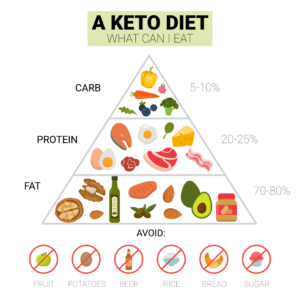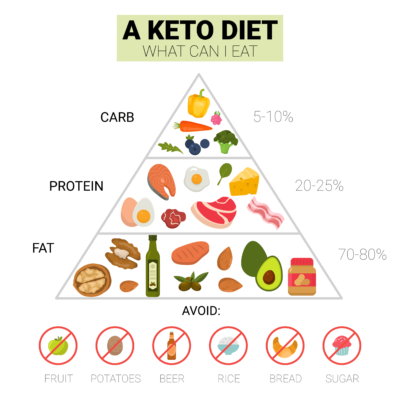A lot of people have been helped with their weight management journey by following the Keto diet. Although it’s a diet that’s been divided. One version of the diet starter ~100 years ago. The second is more modern and influenced by today’s eating patterns. The second version of the keto diet is “dirty keto” and the first is “clean keto”.
How do you figure out which keto diet is right for you?
The keto diet is useful for weight loss and weight control. Many studies show there is a wide variety of other health and wellness benefits. Clean keto helps to increase energy levels, improve brain function, and athletic performance. Dieters who are experiencing the clean keto benefits may wonder what the newer “dirty keto” has to offer compared to “clean keto”. So let’s spend some time comparing dirty keto and clean keto.
Comparing dirty keto and clean keto
Clean keto
 The basis of clean keto is to eat a fixed number of macronutrients composed of high-fat, moderate protein, and a very low amount of carbohydrates. These macronutrients will give you the energy your body needs while you lose body fat without feeling hungry, weak, or fatigued. By reducing your consumption of carbohydrates your body enters a state of ketosis. When you’re in ketosis your body’s primary source of energy is ketones, not sugar. Ketones are made in your liver by converting fat. They are a fantastic energy source for both body and brain and increase the Brain-Derived Neurotrophic Factor (BDNF). From Wikipedia, “BDNF acts on certain neurons of the central nervous system and the peripheral nervous system, helping to support the survival of existing neurons, and encouraging growth and differentiation of new neurons and synapses.”
The basis of clean keto is to eat a fixed number of macronutrients composed of high-fat, moderate protein, and a very low amount of carbohydrates. These macronutrients will give you the energy your body needs while you lose body fat without feeling hungry, weak, or fatigued. By reducing your consumption of carbohydrates your body enters a state of ketosis. When you’re in ketosis your body’s primary source of energy is ketones, not sugar. Ketones are made in your liver by converting fat. They are a fantastic energy source for both body and brain and increase the Brain-Derived Neurotrophic Factor (BDNF). From Wikipedia, “BDNF acts on certain neurons of the central nervous system and the peripheral nervous system, helping to support the survival of existing neurons, and encouraging growth and differentiation of new neurons and synapses.”
Most of your calories come from healthy fats, nuts, and seeds. Be mindful that some nuts and seeds are suited to the keto diet more than others. Nuts and seeds with the highest amount of fat and the lowest amount of carbs are the ones you want to include in your keto diet (i.e., almonds, brazil nuts, walnuts, chia seeds, flaxseeds, etc.). The keto diet allows for eating lots of leafy green vegetables and other low-carb vegetables. Additionally, eat moderate amounts of protein from meat, fish, poultry, and eggs. Lastly, you curb your sweet tooth with a piece of 90% dark chocolate.
Some foods to avoid on the keto diet are those with high amounts of carbohydrates. Limit your consumption of fruit due to the high sugar content and avoid fruit juices entirely for the same reason. Avoid grains, legumes, and root vegetables because of their carb count.
Dirty keto
The dirty keto diet follows the same macronutrient guidelines as the clean keto diet. The difference is with dirty keto it doesn’t matter where those macronutrients come from. For example, dirty keto allows you to have a fast-food hamburger, pork rinds, and Cheese Whiz. Whereas clean keto encourages good fats, grass-fed meats and butter, wild-caught fish, and avocados.
Can you control your weight with a dirty keto diet?
It’s certainly possible, but most of the benefits stop there. There are notable deficiencies that you should be aware of. To begin, the dirty keto diet won’t provide you with the  micronutrients you need such as vitamins and minerals needed for general health. Additionally, processed foods are loaded with sodium that can cause inflammation and bloating.
micronutrients you need such as vitamins and minerals needed for general health. Additionally, processed foods are loaded with sodium that can cause inflammation and bloating.
On top of that you’re more likely to put any weight you lose back on, have more cravings, and feel less satiated. Dirty keto foods may cause cravings, bloating, and a feeling of withdrawal. These are all symptoms associated with the so-called “keto flu”.
You are what you eat
When your digestive system is healthy the small and large intestines are built with a paper-thin lining. In normal healthy conditions, only water and digested food will enter your blood. When you’re experiencing inflammation of the intestines, or consume inappropriate food, the intestine’s lining becomes too porous.
Diets that include processed food with their added chemistry like those included in a dirty keto diet can damage the intestinal lining, making it more porous. This also affects the balance of both the good and bad bacteria found in our intestines. This condition of unbalanced bacteria can allow the bad bacteria to get out of control further increasing how porous the lining becomes. Resulting in a “leaky gut”, also called “intestinal hyperpermeability”, allowing toxins, bacteria, and particles of undigested food to get in your blood and move through the rest of the body including the brain.
Your gut affects your mental state and overall physical feeling. Likewise, your mental state affects your gut and its health, making the clean keto diet the better choice for your brain’s well-being.
Summary
Even though dirty keto seeks the same macronutrients as clean keto does, there are some stark differences between the two diets and how they influence your body and brain. A dirty keto meal is better than a standard American diet meal and can be eaten as a contingency meal, but a dirty keto diet shouldn’t be used as part of a continuing healthy eating program. Follow a clean keto diet instead and you’ll be successful at controlling your weight, increasing your energy level, as well as giving your brain a healthier, longer-lasting fuel.


